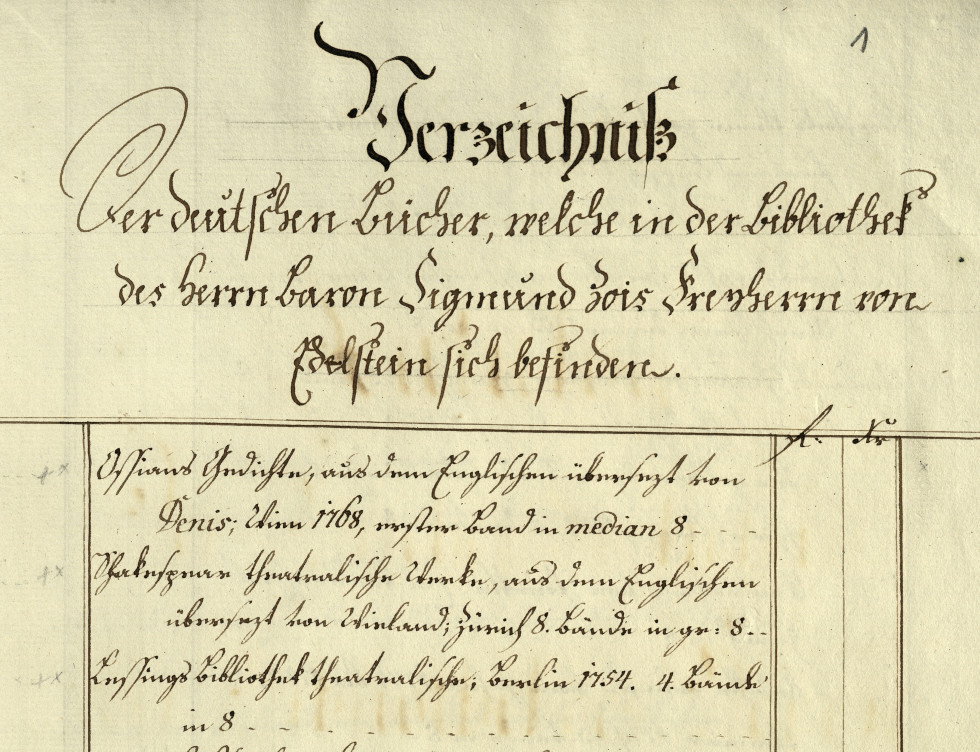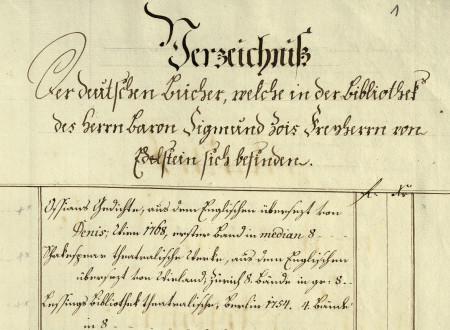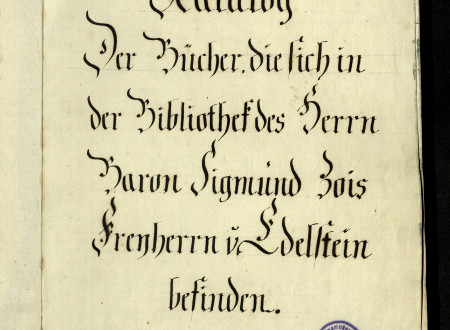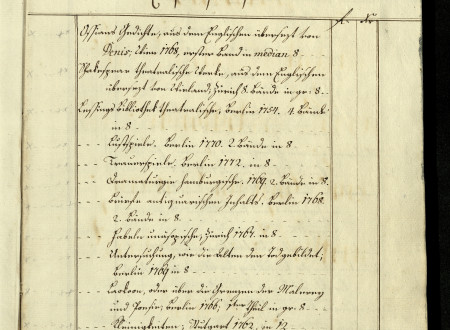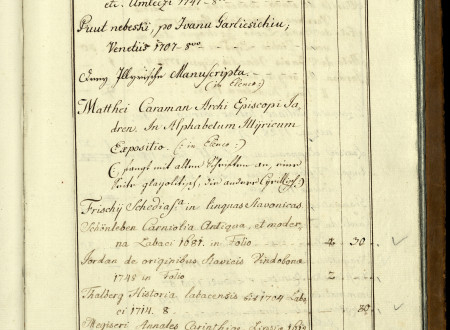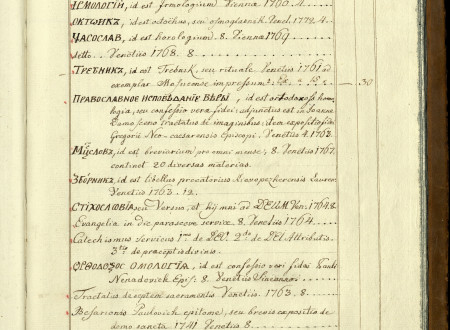Catalogue of the Books Owned by Žiga Zois
Catalogue of the Books Owned by Žiga Zois
This month's archivalia presents one of the catalogues of the books owned by Žiga Zois, a member of the Enlightenment movement, patron of arts and literature, natural scientist, economist, and ironworker, whose 200th anniversary of death we are commemorating this year. He was born in Trieste on November 23, 1747 into a family of a wealthy and successful merchant, a native of the Bergamo region, on whom a hereditary title of Baron was conferred by the Empress Maria Theresia in 1760. Having been initially educated at his father’s house, Žiga and his two brothers departed for Reggio Emilia in 1761 to attend a school for lay pupils of its spiritual seminary. At his father’s request, he returned to Ljubljana in 1765 to prepare himself for the taking over of the family trade business. While learning the ropes of the business, he studied natural and other sciences useful for the field of mining and ironworks. He was likewise interested in technical issues, he supported research and strove for the progress and general improvement of craft practices. If requested by the authorities of the time, he also reviewed and commented on the plans for the improvement of navigability of the rivers Sava and Ljubljanica, as well as on the plans for the draining of the Ljubljana Marshes. At the start of 1779 he set off on a trip across Central Europe, where he visited some of the ironworks and trade companies, and where he probably also made contacts with various natural scientists, since he was also an amateur mineralogist. In Rome he experienced his first gout attack and came back home in 1780 with this illness that was to have an effect on him for the rest of his life. In 1782, he spent several weeks in the Belgian health resort Spa and visited Amsterdam. His illness steadily progressed and in 1793 his legs were paralysed; he himself made plans for a wheelchair that he used to move around his house, and since 1797 he was no longer able to leave his home. He died on November 10, 1819 in Ljubljana.
Two of the most important collections kept by Žiga Zois at his house in the Breg in Ljubljana were his collection of minerals and his library. Books from his library, which at the time was one of the richest and largest private libraries both in the Slovenian territory as well as within a wider geographical area, provide a glimpse into areas of interest that he devoted his time to. He began collecting books already during his younger years, and systematic complementation of his library holdings was something he kept in mind during every one of his study or business trip abroad. In this respect, his command of foreign languages came in handy; apart from German, Italian and Latin, he was also proficient in Slovene and was improving his English and French, while among Slavic languages he was learning Old Church Slavonic with Glagolitic and Cyrillic script. For business reasons he also came into contact with Swedish and Latvian language.
When he was no longer able to travel, he ordered books from booksellers in Ljubljana, from antique book shops and book agents, or he asked his colleagues and friends for their help in finding certain prints that caught his interest. In his search for books he often appealed for the help of “Zois’s company at table”, which consisted of his friends and supporters, such as Blaž Kumerdej, Martin Kuralt, Jernej Kopitar, Jožef Schober, and others. He enriched his library collection with rare editions of books that he purchased from private owners or at auctions. Systematically collected and supplemented library was of utmost importance for the national revival efforts and for the reception of foreign literature among Slovenians. It was visited by the people of Ljubljana, who shared his interest in minerals, botany, history, linguistics, Slavisitcs, and many other sciences. Having made a decision to actively participate in Slovene national revival movement, Zois systematically purchased the literature that was used for the study of Slavic languages and literature. As a bibliophile, he strove to own the old Slovene prints and for those he often turned to his rural acquaintances Anton Gubanc amd Anton Korbič, two book lovers from nearby village of Vodice. During the time of the Illyrian Provinces, any purchasing of books outside of the borders was strictly forbidden, which upset Žiga Zois very much. Apart from that, this was also the time when he experienced some financial difficulties. As soon as he recovered from them, he carried on with his buying of books.
Zois was very worried for the future of his library, which was kept in custom-made bookcases on the second floor of his house and which he hoped to preserve in its entirety. After 1815 he was due to financial difficulties forced to offer his collection of minerals for sale, but such sale never actually took place. When he eventually sold and handed his entire assets over to his nephew Karl in October 27, 1819, his library became Karl’s property as well, except for the Slavic writings and manuscripts. In 1820, the gubernium raised the issue of buying back Zois’s library; its value was estimated in August 1821 by bookseller Henrik Viljem Korn (4109 volumes for 7,263 gulden). On July 24, 1827, the Lyceum Library, a predecessor of today’s National and University Library, was handed over 3885 volumes for a total sum of 7,000 gulden. Zois’s entire book collection is tastefully bound in leather so that the provenience of the books is apparent already at first glance, but, unfortunately, the books are now no longer kept together as corpus separatum.
His library holdings were catalogued several times, and occasionally he compiled such catalogues himself. The first time his books were catalogued was after March 11, 1780, and the second time was around 1797, when Zois’s amanuensis Jožef Schober compiled a list of Slavic books; around 1798, Zois made a catalogue of his Slavic library for his own needs and for those of his club, but, unfortunately, the catalogue is not very precise; around 1803, Kopitar compiled a catalogue of the entire library holdings; around 1810, Jakob Zupan, with some help from Zois himself, catalogued Zois’s collection of Slavic books for Josef Dobrovski, and among the last ones is a catalogue with prices from 1821, which served as a basis for sale, but was not identical to the main, now lost, catalogue of books mentioned in purchase contract of October 27, 1819.
Some of the lists of the books that were owned by Žiga Zois are today kept also by the Archives of the Republic of Slovenia. The most extensive of them is a catalogue which is bound into a book and undated, and is presented here as this month’s archivalia. It was compiled over a period of time, which is evident from different handwritings used to enter the titles of books and at times from incomplete data about the value of individual books. In the first part of the catalogue, the books are entered according to language (German, French, Latin, Italian, English), and the second part contains a couple of shorter lists, where books are entered according to their form and subject (Manuscripta, Lexica, Grammaticalia, Abecedaria, seu Buquar, Bonarum Artium, Historica, Ecclesiastica, Signification der schwedischen Bücher). The catalogue of books, which was digitised at the National and University Library and was included among the manuscript collection of Žiga Zois is now also available online at the Digital Library of Slovenia - dLib.
Alenka Kačičnik Gabrič


